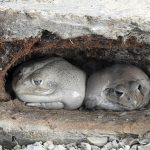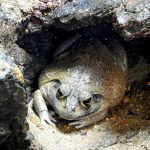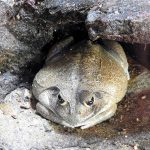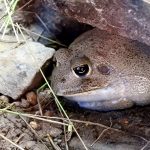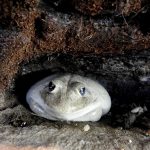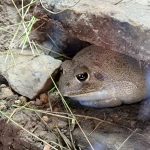WATER-HOLDING FROG
Water-holding Frog: Australia’s underground water vault
Picture a dry claypan under a sky pale with heat. The soil is powder-fine, the air still, and the scent is dust and saltbush. Then, one afternoon, thunder rolls across the horizon. The first raindrops strike the ground with a soft patter, releasing that distinctive earthy smell of wet soil. Within hours, shallow pools form, insects lift in shimmering clouds—and from beneath the sand, a quiet nation of sleepers awakens.
Among them is the Water-holding Frog—round-bodied, smooth-skinned, and perfectly adapted to turn a brief rainstorm into a season of life. As dusk settles, its low, rhythmic croaks rise from the new puddles, a chorus timed to the heartbeat of the desert.
Quick facts
| Feature | Detail |
|---|---|
| Scientific name | Ranoidea platycephala (syn. Cyclorana platycephala) |
| Family | Hylidae (tree frog family; a burrowing specialist) |
| Status | Least Concern |
| Size | About 6–9 cm (snout–vent length) |
| Range | Arid and semi-arid Australia: WA, NT, SA, also inland QLD and NSW |
| Habitat | Sandy flats, claypans, spinifex grasslands, ephemeral wetlands |
| Diet | Insects and other small invertebrates; highly opportunistic |
| Call | Low, guttural, repetitive croaks—most often after heavy rain |
| Breeding trigger | Intense rainfall, temporary pools |
| Key adaptation | Aestivation underground with water stored in body tissues |
How to recognise one
- Shape: Robust and slightly rotund, with a broad, flattened head and body.
- Skin: Smooth, in soft greens or browns that blend with sand and leaf litter.
- Limbs: Strong back legs and shovel-like inner “spades” for reverse digging.
- Camouflage: Muted tones make the frog nearly invisible against arid soils.
When fully hydrated, the frog looks plumper—its body literally “tanks up” on water.
Life underground: the art of aestivation
For much of the year the Water-holding Frog is a silent presence beneath the surface. It burrows down tail-first, settles into a chamber, and sheds layers of skin to form a thin cocoon that slows water loss. Water is stored within its bladder and body tissues, and it can draw moisture from damp soil through its skin—especially the belly patch.
- Duration: Many months, sometimes longer, depending on conditions.
- Benefit: Survives extreme heat and drought where other amphibians cannot.
This strategy turns the frog into a living reservoir, a remarkable solution to an unforgiving climate.
Feeding: making the most of brief abundance
When the rains break the drought, the frog emerges at night to feed. It is an opportunist:
- Prey: Beetles, ants, termites, moths, and other small invertebrates.
- Strategy: Rapid energy gain to rebuild reserves for the next dry spell.
The desert hums after rain, and the frog harvests that pulse of life while it lasts.
Breeding and the rain’s green light
Breeding is tightly timed to heavy rainfall:
- Rains fill hollows and claypans.
- Males gather at temporary pools and call—low, guttural croaks that carry over the water.
- Females lay eggs in the shallows.
- Tadpoles race through development—often within a few weeks—before the water disappears.
These pools are usually fish-free, which increases the young frogs’ chances, but the clock is relentless; drying winds and rising temperatures mean every day counts.
Lifespan and resilience
Water-holding Frogs can live several years. Their true strength is not longevity, but flexibility—long periods in dormancy punctuated by short bursts of activity when rain appears. This rhythm mirrors the heartbeat of Australia’s inland.
Cultural knowledge
First Nations peoples have long understood the Water-holding Frog’s link to rain and survival in dry country. This knowledge is part of living cultures and Country and deserves respect. Today, the best way to honour that relationship is to protect both the species and the habitats it depends on—and to avoid disturbing wildlife.
Conservation: quiet guardians of the claypan
The species is currently listed as Least Concern, yet its future depends on the health of arid landscapes:
- Pressures: Habitat disturbance, groundwater extraction, altered fire regimes, invasive species, and climate change shifting rainfall patterns.
- What helps:
- Safeguarding ephemeral wetlands and surrounding dune systems.
- Sensitive grazing and land management to prevent soil compaction.
- Responsible water use and protection of natural floodplains.
- Keeping pets contained and supporting control of invasive predators.
Each intact claypan and unbroken expanse of sand becomes a refuge when the storm clouds finally gather.
When the last puddles shrink and birds fall silent, the Water-holding Frog returns to the earth. The ground closes over, warm and dry. Months may pass with no sign of life at all. But deep below, a small heart waits, a body holding water and memory—ready for the smell of rain, the cool touch of muddy sand, and a chorus that begins again under a silvered desert sky.

